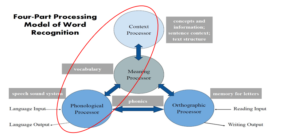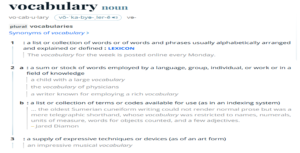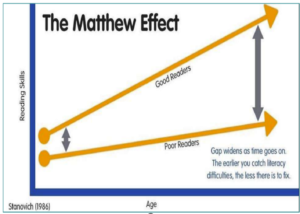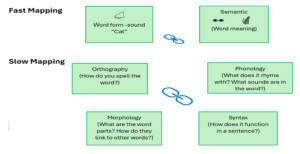Vocabulary

Vocabulary refers to the words students must know to communicate effectively through reading and writing. It includes understanding the meaning of words, their pronunciation and how they are used in different contexts.
Dictionary Definition

Source : VOCABULARY Definition & Meaning – Merriam-Webster
Etymology of Vocabulary (n)
1530s, “a list, with brief definitions or explanation, of words,” from Medieval Latin vocabularium “a list of words,” from Latin vocabulum “word, name, noun,” from vocare “to name, call,” which is related to vox (genitive vocis) “voice” (from PIE root *wekw- “to speak”).
Often words of a specific book or author, as opposed to a dictionary, which aims to be more comprehensive. The meaning “range of words in the language of a person or group” is attested from 1753; that of “sum of words in a language” is by 1782..
vocabulary | Etymology of vocabulary by etymonline
Vocabulary is often categorized as oral vocabulary / oral language (listening and speaking) and print vocabulary (reading and writing). The goal of vocabulary instruction is to provide students with an understanding of the meaning/s and use of words so that they can apply this knowledge to comprehend text and communicate effectively. The purpose of vocabulary instruction in the classroom is to extensively expand oral vocabulary while developing print vocabulary.
The strong relationship between vocabulary instruction and comprehension has been accepted and acknowledged for many years (Cunningham, 2005). The individual words in a text provide the foundation of comprehending at sentence, paragraph and whole text levels.
There are different degrees of vocabulary knowledge, of a word meaning/s. Vocabulary knowledge needs to be developed beyond a shallow level (simple word recognition), to a detailed knowledge of word, depth. Which can be described as knowledge of the relationship and associations between words and concepts. Research has proven that deep vocabulary knowledge is critical to comprehending text.
Reading Comprehension occurs in real time, so it is crucial that the reader can access word meanings and other knowledge rapidly and accurately. Thus speed and activation of word meaning is important for comprehension. (Cain, Oakhill and Elbro, 2015)
Teaching vocabulary can most effectively support and foster reading comprehension when we explicitly teach children the meaning of specific words and help then become better at working out the meaning of new words independently. Through explaining key vocabulary in a text and linking them to prior knowledge, teachers can assist students in building a mental model.
The Tiered Vocabulary Model (Beck and McKeown, 2013) provides teachers with a framework to help them target specific Tier 2 words for direct instruction. These words are considered the most useful words to teach as they are frequently encountered across different content or subject areas. We will dive deeper into this model later.
Now listen to Lyn Stone, linguist, author and owner of Lifelong Literacy explain the vital role of explicitly teaching vocabulary https://youtu.be/hJSTFEeh0Rk Vocabulary
https://youtu.be/hJSTFEeh0Rk?si=T-m354I7zmMtR-tm
Now Listen to the Reading Rockets webcast series episode Make Reading Count
Make Reading Count | Reading Rockets
In this webcast Isabel Beck, Nanci Bell, and Sharon Walpole discuss the components for developing good reading comprehension skills, identifying potential stumbling blocks, and offering strategies teachers can use in the classroom.

The Matthew Effect
The Matthew Effect is a concept that references a Bible verse that basically says the rich get richer and the poor get poorer. Matthew 25:29
The Matthew effect in reading, is a term coined by psychologist Keith Stanovich (1986). It refers to the widening gap and progressive decline between slow starters and fast starters over time. The report (link attached for your reference) uses a framework to explain some persisting problems in the literature on reading disability.
This phenomenon highlights how good readers become increasingly proficient over time, whilst poor readers fall further and further behind. As early reading success leads to fluency and comprehension, the gap between skilled and struggling readers widens.
This, in turn, creates a self-reinforcing cycle that can either benefit or hinder a student’s opportunities for further learning and future success. This concept emphasises the importance of early intervention to help bridge this gap and support those who do not naturally excel in reading.
Stanovich, Keith. (1986). Matthew Effects in Reading: Some Consequences of Individual Differences in the Acquisition of Literacy. Reading Research Quarterly. 21. 360-407. 10.1598/RRQ.21.4.1.
Key Elements of Effective Vocabulary Instruction
Previous vocabulary instruction in classrooms often heavily relied on students copying out definitions from the dictionary. As the American author, poet and civil rights activist, Maya Angelou would say,
“Do the best you can until you know better. Then, when you know better, do better.”
Effective vocabulary instruction has a number of key elements which need to be considered when planning vocabulary instruction.
Read Tim Shanahan’s article, Five Things Every Teacher Should Know about Vocabulary Instruction | Reading Rockets and consider how you introduce new vocabulary in your classroom.
Explicit Vocabulary Instruction
Explicit vocabulary instructional strategies are highly beneficial because they help students learn a set of new words that are useful in meaningful contexts.
Vocabulary instruction should not be isolated to the teaching of reading but instead be part of all key learning areas e.g. Math, Science, Art, Biology, Physics, Geography, History etc.
Research has evidenced that deeper vocabulary instruction has a greater impact on later learning and the student’s ability to apply their knowledge for the purpose of comprehending texts and writing.
The goal is not to memorize definitions, but instead, word definitions and deep exploration of the word allows students to build a conceptual understanding of what words stand for and how they connect to other words on the same subject or that mean similar things.
Listen to Lyn Stone, linguist, author and owner of Lifelong Literacy, share her knowledge about The Science of Reading Beyond Phonics.
Ep. 155: Science of Reading Beyond Phonics: Language for Life with Lyn Stone
Podcasts, Videos and Resource links for your exploration
Melissa & Lori Love Literacy ™
Vocabulary – teaching morphology and roots
Five Key Principles for Effective Vocabulary Instruction | Reading Rockets
Word Analysis to Expand Vocabulary Development | Reading Rockets
Breaking Down New Words Worksheet.pdf
Bing Videos Learn English Vocabulary | Common Words and Meanings | 21 Lessons
How do we learn words

Research has shown that the process of Slow Mapping of new vocabulary is far superior to Fast Mapping. Students require deep vocabulary instruction whereby they are given multiple opportunities to unpack the word and ultimately store it in their long-term memory for instant and effortless retrieval.
Cognitive Overload Theory – Learning new Vocabulary

(Storage & Retrieval Diagram based on the work of Sweller,2016)
Students require on average 3 to 9 exposures to a new word, for it to be stored in their short-term memory. However, it takes regular opportunities to practice, rehearse and retrieve the word, through spaced repetition to enhance long term memory.
For more information about Cognitive Load Theory, AERO have provided a great resource that you can access via the link below.
Managing cognitive load optimises learning | Australian Education Research Organisation
